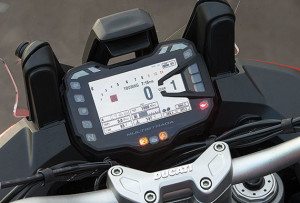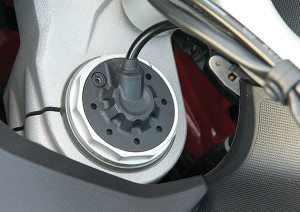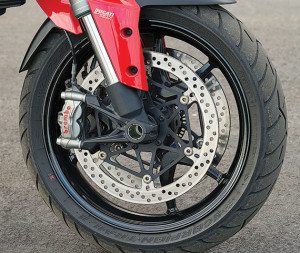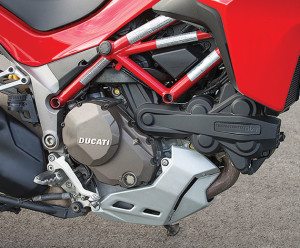
When Ducati introduced the Multistrada 1200 for 2010, it injected a big dose of performance into the utilitarian adventure segment. BMW’s R 1200 GS had long dominated the class, offering the best balance of on-road manners, off-road capability and touring versatility, and its updated-for-2010 air-cooled, radial-valve boxer twin made 93 horsepower and 73 lb-ft of torque at the rear wheel (Rider, August 2010). Rather than go head-to-head with the GS, Ducati staked its claim on the sporty end of the adventure-touring spectrum. Bolted into the Multistrada’s trellis frame was the Testastretta L-twin from Ducati’s 1198 superbike, retuned for the street. When we tested it in July 2010, it spun the dyno to 138 horsepower and 85 lb-ft of torque at the rear wheel, and Editor-in-Chief Tuttle described it as “one light, fast rocketship with a ferocious bark.”
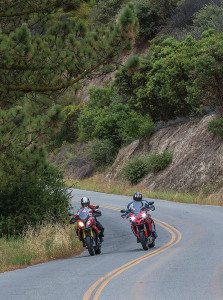
The Multistrada quickly became one of Ducati’s best-selling models, helping the company weather strong headwinds during the long, slow global economic recovery. To broaden the Multistrada’s appeal, it was updated for 2013 with a dual-spark cylinder head and other engine changes for smoother running and better torque and fuel economy. It also got multiple ABS modes and, on S models, semi-active Ducati Skyhook Suspension. For 2015, Ducati further enhanced the Multistrada’s performance and touring capabilities by adding Desmodromic Variable Timing (DVT), Ducati Wheelie Control, cornering ABS, cruise control and improved ergonomics and wind protection. DVT, which uses hydraulic phasers to adjust valve overlap for smooth power delivery down low and maximum thrust at high revs, boosts claimed output to 160 horsepower and 100 lb-ft of torque. (For more details, check out our test from the June 2015 issue.) BMW tolerated Ducati’s competitive threat for a while, but ultimately it had to respond. Unwilling to jeopardize its golden goose, the R 1200 GS was kept on the steady path of evolution it has followed for more than three decades. Instead, BMW turned its powerful naked sportbike, the S 1000 R, into an adventure bike, the new-for-2016 S 1000 XR (read our full test here).
Side-by-side, the Multistrada 1200 DVT S and S 1000 XR appear evenly matched. Despite different displacements and configurations—the Ducati has an 1,198.4cc L-twin, the BMW has a 999cc in-line four—both are powered by superbike-derived engines that make a claimed 160 horsepower at the crank (the Ducati has the torque advantage, 100 lb-ft vs. 83). With top-of-the-line specifications as on our test bikes—an S model with Touring Pack for the Ducati and a Premium Package-equipped BMW—both have multiple engine modes, traction control, semi-active suspension and Brembo brakes with cornering ABS. They’re both outfitted with cruise control, adjustable windscreens, hand guards, heated grips, centerstands and power outlets. They even have similar pointy-beak, bird-of-prey styling and come in nearly identical shades of red or white. Let the rivalry commence!
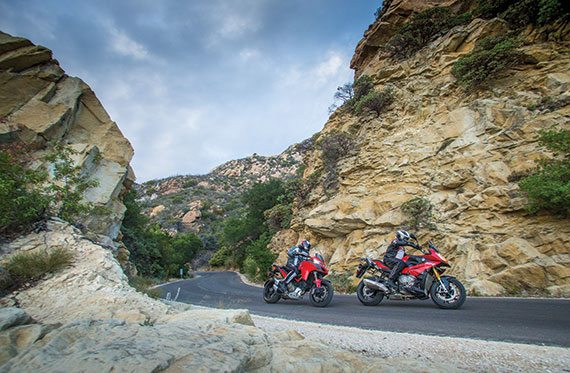
First things first: Results of the horsepower contest are inconclusive due to a technicality. When we put the BMW on Jett Tuning’s dyno, it made 151.6 horsepower at 11,300 rpm and 76.6 lb-ft of torque at 9,200 rpm at the rear wheel. Even though the engine is the same in the S 1000 R and S 1000 XR, these numbers are a bit lower that what we reported for the R in our July comparison test, most likely due to the XR’s longer, less racy exhaust. The Ducati, on the other hand, posted numbers well below expectations, slightly lower than what we reported for the 2013 Multistrada (139 horsepower and 85 lb-ft of torque; August 2013). Today’s high-end motorcycles are laden with complex electronic systems and an array of sensors that communicate with each other. New on the Multistrada is a Bosch Inertial Measurement Unit (IMU) that computes speed and acceleration in five different axes, and it talks to the ECU and other systems. When a bike is put on a dyno, it and the front wheel remain stationary while the rear wheel spins up to maximum speed at redline in 4th gear. Motorcycles don’t normally operate that way, which can cause one or more sensors to produce an error code that tells the ECU to dial back performance. In the case of the Ducati, this could be to prevent the new variable-valve timing system from causing damage to the engine.
Absolute performance numbers are important for bragging rights, but seat-of-the-pants performance is what really matters. Out of the laboratory of the dyno room and in the real world of cambered and curved asphalt, the Multistrada feels stronger than ever. Previous models surged and bucked below 4,000 rpm, but DVT helps it pull smoothly and strongly down low. A big jump in torque between 3,000-4,000 rpm catapults the Ducati out of corners, but a major dip between 5,000-6,000 rpm bogs it down before the grunt kicks in again. Even with the caveat that its dyno results are lower than they should be, the Ducati still posts a big advantage in horsepower and torque over the BMW between 6,000-8,500 rpm—right in the heart of the midrange. With its booming exhaust, throbbing L-twin and major-league power, the Multistrada is very much a superbike at heart, but three generations of development have smoothed many of its rough edges.

The S 1000 XR, on the other hand, feels intense and precise, like a laser-guided weapon. Its in-line four is high-strung and at times excessively buzzy, but power delivery is more even and linear than on the Multistrada, and throttle response is more direct. There’s nothing docile or relaxed about the XR, which constantly eggs you on—faster, faster, faster! And, boy, when given the spurs it howls like a screamin’ demon. Both bikes send power to the rear wheel through 6-speed transmissions with slipper clutches and chain final drive, but the BMW offers an added bonus: Gear Shift Assist Pro, which allows lightning-quick clutchless up- and downshifts.
A detailed comparison of the riding modes on these bikes would fill this entire magazine, but a brief rundown is in order. The Ducati’s four modes (Sport, Touring, Urban and Enduro) adjust nearly everything for different riding conditions: power output, throttle response, traction control, wheelie control, ABS and suspension damping. The BMW also has four modes (Dynamic Pro, Dynamic, Road and Rain), which make similar adjustments, but the S 1000 XR does not have wheelie control and suspension damping must be changed separately. Not only is the Ducati’s electronics package more integrated, it has the added versatility of an Enduro mode and the ability to customize any setting within any mode.
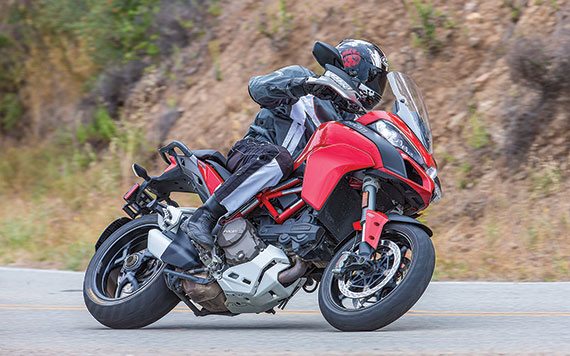
Equally impressive are the bikes’ semi-active suspension systems that automatically adjust damping based on road conditions and various sensor inputs (rear preload is adjusted electronically via presets). The BMW’s Dynamic ESA system has only two modes—Dynamic and Road—and both deliver excellent compliance but are on the stiff side. We’d like to have a “Comfort” mode for extended or two-up touring. Ducati Skyhook Suspension Evo has different settings for each mode and can be customized. The Sport setting is firm, but the Touring mode feels vague over irregular pavement, as if the system is struggling to reconcile chassis stability and comfort.
Stout chassis, sporty steering geometry and wide handlebars give both bikes impressive handling. On California Route 33, a favorite test road we know by heart, the BMW and Ducati felt glued to the tarmac, their semi-active suspensions working their magic. But the BMW feels more planted and instills greater confidence, which could be due in part to its grippy, dual-compound Bridgestone Battlax T30 sport-touring tires (the Ducati is shod with Pirelli Scorpion Trail II 90/10 adventure tires). Also, even though the S-model Multistrada has powerful Panigale superbike-spec Brembo Monobloc front calipers, the BMW’s lower-spec Brembos offer superior feel at the lever.
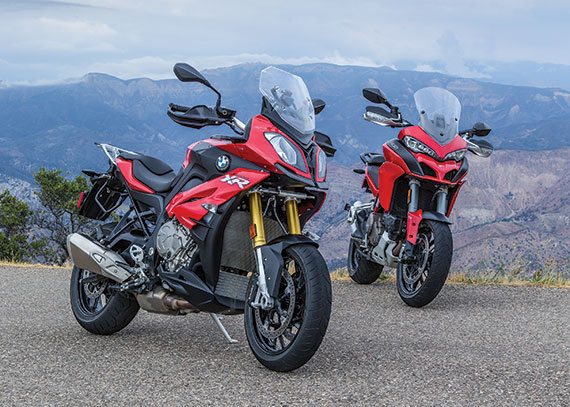
Seating positions are similar, but the Ducati feels more plush and relaxed, with a height-adjustable seat that’s softer than the BMW’s firm but well-shaped saddle. The Multistrada’s fairing is broader and offers more protection, and its windscreen is larger and has a pinch-and-slide feature for easy one-hand adjustment. The S-model’s instrumentation is a very detailed, full-color TFT display and Bluetooth connectivity is available. By contrast, the S 1000 XR feels austere, lacking info you need (like ambient temperature) and including features you don’t (like a lap timer). The Ducati’s Touring Pack ($1,399) includes heated grips, a centerstand and 58-liter saddlebags that look and work great. The BMW’s Premium Package includes heated grips, a centerstand and saddlebag mounts; 62-liter Touring Cases in red cost another $970.90.
Motorcycles, believe it or not, are like politicians. Both try to appeal to different demographic groups and their positions change over time. When Ducati introduced the Multistrada 1200 for 2010, it staked out an extreme position on the adventure-bike spectrum, offering far more power than the competition. With model updates that followed, Ducati tried to grow the Multistrada’s base, moving it toward the center with more touring features, improved comfort and a less rambunctious engine. That’s in part because the Multistrada carries the burden of being Ducati’s only adventure/sport tourer. BMW, on the other hand, has its political bases covered with multiple adventure bikes and sport tourers in its lineup. That freed it up to outflank Ducati with the S 1000 XR, a sportbike with adventure-bike styling and ergonomics that’s harder-edged and more narrowly focused than the Multistrada. Both bikes offer comparable levels of power and sophistication that will spoil you, but the Ducati is the more versatile, comfortable and touring-friendly of the two. It gets our vote.
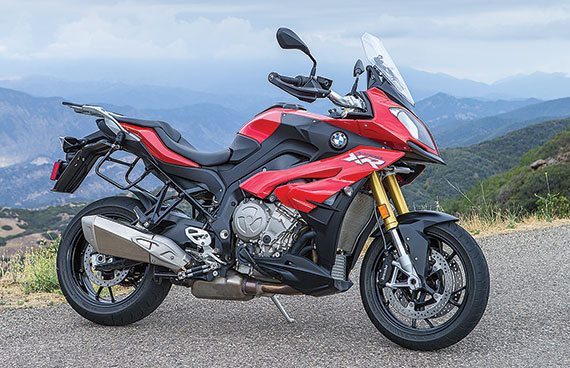
2016 BMW S 1000 XR Specs
Base Price: $16,350
Price As Tested: $18,750 (Premium Package)
Warranty: 3 yrs., 36,000 miles
Website: bmwmotorcycles.com
Engine
Engine Type: Liquid-cooled, transverse in-line four
Displacement: 999cc
Bore x Stroke: 80.0 x 50.0mm
Compression Ratio: 12.0:1
Valve Train: DOHC, 4 valves per cyl.
Valve Insp. Interval: 18,600 miles
Fuel Delivery: BMS-X EFI
Lubrication System: Wet sump, 4.1-qt. cap.
Transmission: 6-speed, cable-actuated wet slipper clutch
Final Drive: O-ring chain
Electrical
Ignition: Digital electronic
Charging Output: 350 watts max.
Battery: 12V 8AH
Chassis
Frame: Aluminum bridge-type w/ engine as stressed member & cast aluminum swingarm
Wheelbase: 61.0 in.
Rake/Trail: 25.5 degrees/4.6 in.
Seat Height: 33.1 in.
Suspension, Front: 46mm USD fork w/ Dynamic ESA (as tested) & 5.9-in. travel
Rear: Single shock w/ Dynamic ESA (as tested) & 5.5-in. travel
Brakes, Front: Dual 320mm floating discs w/ opposed 4-piston radial calipers & Integral ABS
Rear: Single 265mm disc w/ 2-piston floating caliper & ABS
Wheels, Front: Cast, 3.50 x 17 in.
Rear: Cast, 6.00 x 17 in.
Tires, Front: 120/70-ZR17
Rear: 190/55-ZR17
Wet Weight: 531 lbs. (as tested)
Load Capacity: 426 lbs. (as tested)
GVWR: 957 lbs.
Performance
Fuel Capacity: 5.2 gals., last 1.0 gal. warning light on
MPG: 91 PON min. (high/avg/low) 38.9/34.6/30.3
Estimated Range: 180 miles
Indicated RPM at 60 MPH: 4,250
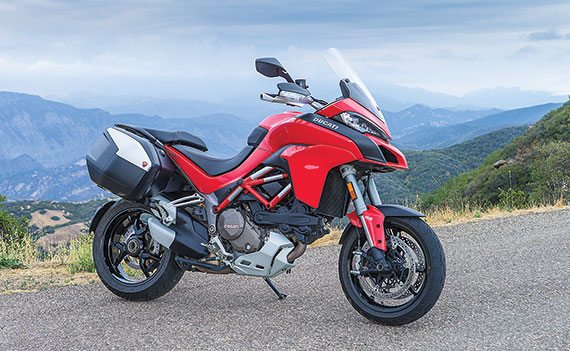
2015 Ducati Multistrada 1200 DVT S Specs
Base Price: $19,695 (Ducati Red)
Price as Tested: $21,094 (Touring Pack)
Warranty: 2 yrs., unltd. miles
Website: ducatiusa.com
Engine
Type: Liquid-cooled, transverse 90-degree L-twin
Displacement: 1198.4cc
Bore x Stroke: 106.0 x 67.9mm
Compression Ratio: 12.5:1
Valve Train: Desmodromic DOHC w/ DVT & 4 valves per cyl.
Valve Insp. Interval: 18,640 miles
Fuel Delivery: Bosch EFI w/ 56mm elliptical throttle bodies x 2
Lubrication System: Wet sump, 4.1-qt. cap.
Transmission: 6-speed, hydraulically actuated wet slipper clutch
Final Drive: O-ring chain
Electrical
Ignition: Electronic digital
Charging Output: 500 watts max.
Battery: 12V 12AH
Chassis
Frame: Tubular-steel trellis w/ single-sided aluminum swingarm
Wheelbase: 60.2 in.
Rake/Trail: 24 degrees/4.3 in.
Seat Height: 32.5/33.3 in.
Suspension, Front: 48mm USD fork w/ DSS Evo (as tested) & 6.7-in. travel
Rear: Single shock w/ DSS Evo (as tested) & 6.7-in. travel
Brakes, Front: Dual 330mm semi-floating discs w/ opposed 4-piston radial calipers, linked front-to-rear & ABS
Rear: Single 265mm disc w/ 2-piston floating caliper & ABS
Wheels, Front: Cast, 3.50 x 17 in.
Rear: Cast, 6.00 x 17 in.
Tires, Front: 120/70-R17
Rear: 190/55-R17
Wet Weight: 544 lbs. (as tested, saddlebags add 21 lbs.)
Load Capacity: 448 lbs. (as tested)
GVWR: 992 lbs.
Performance
Fuel Capacity: 5.3 gals., last 1.1 gals. warning light on
MPG: 91 PON min. (high/avg/low) 46.5/40.0/36.7
Estimated Range: 212 miles
Indicated RPM at 60 MPH: 3,400

